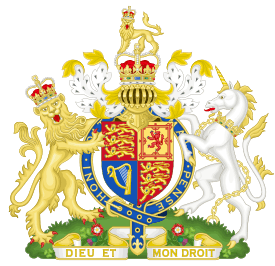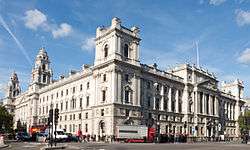HM Treasury
 | |
| Department overview | |
|---|---|
| Formed | 1066 or earlier[1] |
| Jurisdiction | United Kingdom |
| Headquarters |
1 Horse Guards Road Westminster, London |
| Employees | 1169 FTE (+113 in DMO)[2] |
| Annual budget | £3.8 billion (current) & £300 million (capital) for Chancellor's Departments in 2011–12[3] |
| Minister responsible | |
| Department executive | |
| Child Department | |
| Website |
www |
.svg.png) |
| This article is part of a series on the politics and government of the United Kingdom |
|
|
|
|
Her Majesty's Treasury (HM Treasury), sometimes referred to as the Exchequer, or more informally the Treasury, is the British government department responsible for developing and executing the government's public finance policy and economic policy. The Treasury maintains the Online System for Central Accounting and Reporting (OSCAR), the replacement for the Combined Online Information System (COINS), which itemises departmental spending under thousands of category headings,[4] and from which the Whole of Government Accounts (WGA) annual financial statements are produced.
The leading pronoun in the department's name varies depending upon the sex of the reigning monarch.
History
The beginnings of the Treasury of England have been traced by some to an individual known as Henry the Treasurer, a servant to King William the Conqueror.[5][6][7] This claim is based on an entry in the Domesday Book showing the individual Henry "the treasurer" as a landowner in Winchester, where the royal treasure was stored.[8]
The Treasury of the United Kingdom thus traces its origins to the Treasury of the Kingdom of England, which had come into existence by 1126, in the reign of Henry I. The Treasury emerged from the Royal Household. It was where the king kept his treasures. The head of the Treasury was called the Lord Treasurer.
Starting in Tudor times, the Lord Treasurer became one of the chief officers of state, and competed with the Lord Chancellor for the principal place. In 1667, Charles II of England was responsible for appointing George Downing, the builder of Downing Street, to radically reform the Treasury and the collection of taxes.
The Treasury was first put in commission (placed under the control of several people instead of only one) in May or June 1660.[9] The first commissioners were the Duke of Albermarle, Lord Ashley, (Sir) W. Coventry, (Sir) J. Duncomb, and (Sir) T. Clifford.[10][11] After 1714, the Treasury was always in commission. The commissioners were referred to as the Lords of the Treasury and were given a number based on their seniority. Eventually the First Lord of the Treasury came to be seen as the natural head of government, and from Robert Walpole on, the holder of the office began to be known, unofficially, as the Prime Minister. Until 1827, the First Lord of the Treasury, when a commoner, also held the office of Chancellor of the Exchequer, while if the First Lord was a peer, the Second Lord usually served as Chancellor. Since 1827, however, the Chancellor of the Exchequer has always been Second Lord of the Treasury.
During the time when the Treasury was under commission, the junior Lords were each paid £1600 a year.[12]
Ministers
As of September 2016, the Treasury Ministers are as follows:
| Minister | Title | Portfolio |
|---|---|---|
| The Rt Hon. Theresa May MP | First Lord of the Treasury | Prime Minister, formal head of the Treasury |
| The Rt Hon. Philip Hammond MP | Overall responsibility | |
| The Rt Hon. David Gauke MP | Chief Secretary to the Treasury | Spending reviews and strategic planning, in-year spending control, public sector pay and pensions, Annually Managed Expenditure (AME) and welfare reform, efficiency and value for money in public service, capital investment |
| Jane Ellison MP | Financial Secretary to the Treasury | Deputising for the Chancellor at Ecofin, EU Budget, strategic oversight of the UK tax system, corporate and small business taxation, European and international tax issues, HM Revenue and Customs, Valuation Office Agency, Finance Bill, pensions policy, Government Actuary's Department |
| Simon Kirby MP | Economic Secretary to the Treasury (City Minister) | Banking and financial services reform and regulation (including the PRA), financial stability, City competitiveness, bank lending and access to finance, Help to Buy, financial conduct and the FCA, asset management, Royal Bank of Scotland, Lloyds Bank, UKFI, retail financial services, consumer finance, financial advice and capability, Equitable Life, foreign exhange reserves and debt management policy, National Savings and Investments, Debt Management Office |
Whips
Some of the government whips are also associated in name with the Treasury: the Chief Whip is nominally Parliamentary Secretary to the Treasury and traditionally had an office in 12 Downing Street. Some of the other whips are nominally Lord Commissioner of HM Treasury, though they are all members of the House of Commons. Whip is a party, rather than a government, position; the appointments to the Treasury are sinecure positions which allow the whips to be paid ministerial salaries. This has led to the Government front bench in the Commons being known as the Treasury Bench. However, since the whips no longer have any effective ministerial roles in the Treasury, they are usually not listed as Treasury ministers.
Lord Young of Cookham, who serves currently as a government whip in the House of Lords, has been named as Treasury spokesman.[13][14]
Permanent Secretaries
| Taxation in the United Kingdom |
|---|
 |
| UK Government Departments |
| UK Government |
| Scottish Government |
| Welsh Government |
|
| Local Government |
|
The position of Permanent Secretary of HM Treasury is generally regarded as the second most influential in the British Civil Service; the last two incumbents have both gone on to be Cabinet Secretary, the only post outranking it.
- Francis Mowatt (1894–1903)
- George Murray (1903–1911)
- John Bradbury (1913–1919)
- Robert Chalmers (1916–1919)
- Warren Fisher (1919–1939)
- Horace Wilson (1939–1942)
- Richard Hopkins (1942–1945)
- Edward Bridges (1945–1956)
- Roger Makins (1956–1959)
- Frank Lee (1960–1962)
- Norman Brook (1956–1963)
- Laurence Helsby (1963–1968)
- William Armstrong (1962–1968)
- Douglas Allen (1968–1974)
- Douglas Wass (1974–1983)
- Peter Middleton (1983–1991)
- Terence Burns (1991–1998)
- Andrew Turnbull (1998–2002)
- Gus O'Donnell (2002–2005)
- Nicholas Macpherson (2005-2016)
- Tom Scholar (2016-current)
As of July 2016 the Second Permanent Secretary is Charles Roxburgh.[15] Between 2007 and 2010, the post of Head of the Government Economic Service (GES) was held jointly by the Managing Director of Macroeconomic and Fiscal Policy in HM Treasury, Dave Ramsden, and Vicky Pryce, Chief Economist in the Department for Business, Innovation and Skills. Ramsden is now sole Head of the GES. The previous Head of the GES was Sir Nick Stern. Management support for GES members is provided by the Economists in Government team, which is located in HM Treasury's building.
Banknote issue
Banknotes in the UK are normally issued by the Bank of England and a number of commercial banks (see Banknotes of the pound sterling). At the start of the First World War, the Currency and Bank Notes Act 1914 was passed, giving the Treasury temporary powers to issue banknotes in two denominations, one at £1 and another at 10 shillings, in the UK. Treasury notes had full legal tender status and were not convertible for gold through the Bank of England. They replaced the gold coin in circulation to prevent a run on sterling and to enable purchases of raw materials for armaments production. These notes featured an image of King George V (Bank of England notes did not begin to display an image of the monarch until 1960). The wording on each note was UNITED KINGDOM OF GREAT BRITAIN AND IRELAND — Currency notes are Legal Tender for the payment of any amount — Issued by the Lords Commissioners of His Majesty's Treasury under the Authority of Act of Parliament (4 & 5 Geo. V c.14). Notes issued after the partition of Ireland from 1922 had the wording changed to read "United Kingdom of Great Britain and Northern Ireland".
The promise (never adhered to) was that they would be removed from circulation after the war had ended. In fact, the notes were issued until 1928, when the Currency and Bank Notes Act 1928 returned note-issuing powers to the banks.[16]
Associated public bodies
Executive agencies of HM Treasury
- UK Debt Management Office, reporting to the Financial Services Secretary, is responsible for government borrowing operations.
Other bodies reporting to Treasury Ministers
- Her Majesty's Revenue and Customs, a non-ministerial government department for which the responsible Minister is the Exchequer Secretary
- Valuation Office Agency, an executive agency of HM Revenue and Customs
- National Savings and Investments, an executive agency of the Chancellor of the Exchequer
- Office for Budget Responsibility, a non-departmental public body of HM Treasury
- Office of Tax Simplification, an independent office of HM Treasury
- Royal Mint, a Treasury-owned coinage company
- UK Financial Investments, a Treasury-owned company with UK banking interests
History of the Treasury Main Building
The Treasury Main Building at 1 Horse Guards Road, often referred to as the Government Offices, Great George Street (GOGGS), was designed by John Brydon following a competition.[17] Construction took place in two phases. The West end was completed in 1908 and the East end was completed in 1917.[17] It was originally built as offices for Board of Education, the Local Government Board, and the Ministry of Works Office; HM Treasury moved into the building in 1940.[17] A major refurbishment of the building was completed under a PFI contract by Bovis Lend Lease in 2004.[18]
See also
- Economy of the United Kingdom
- List of Lords Commissioners of the Treasury
- List of Lord High Treasurers of England and Great Britain
- Lord High Treasurer
- United Kingdom budget
References
- ↑ http://www.hm-treasury.gov.uk/about_history.htm
- ↑ https://www.gov.uk/government/publications/hmt-workforce-management-information-february-2015
- ↑ Budget 2011 (PDF). London: HM Treasury. 2011. p. 48. Retrieved 30 December 2011.
- ↑ Rosenbaum, Martin. "BBC - Open Secrets: How big is the Coins database?". Retrieved 2016-09-06.
- ↑ C. Warren Hollister - The Origins of the English Treasury The English Historical Review Vol. 93, No. 367 (Apr., 1978) Retrieved 2012-06-25
- ↑ Open Domesday Retrieved 2012-06-25
- ↑ HM Treasury:History
- ↑ D C Douglas - William the Conqueror: The Norman Impact Upon England University of California Press, 1 May 1967 ISBN 0520003500 Retrieved 2012-06-25
- ↑ W Lowndes and D M Gill - The Treasury, 1660-1714 Vol. 46, No. 184 (Oct., 1931) Retrieved 2012-06-25
- ↑ Samuel Pepys (R Latham) - The Diary of Samuel Pepys, Esq., F.R.S. From 1659 to 1669 with Memoir, Echo Library, 30 May 2006 ISBN 1847028926 sourced -
 "Downing, George (1623?-1684)". Dictionary of National Biography. London: Smith, Elder & Co. 1885–1900. p. 400.
"Downing, George (1623?-1684)". Dictionary of National Biography. London: Smith, Elder & Co. 1885–1900. p. 400. - ↑ Secondary - from Cambridge Dictionaries
- ↑ (Baron) T B Macaulay - History of England, Volume 1 CUP Archive, 18 Jan 2012 Retrieved 2012-06-25
- ↑ "Resignation of Lord O'Neill and PM response". 10 Downing Street. 23 September 2016.
- ↑ "Ministers". Government of the United Kingdom. Retrieved 30 September 2016.
- ↑ "New Second Permanent Secretary to the Treasury appointed". GOV.UK. 4 July 2016. Retrieved 23 October 2016.
- ↑ Trevor R Howard. "Treasury notes". Retrieved 12 October 2007.
- 1 2 3 HM Treasury: About GOGGS
- ↑ HM Treasury case study
External links
Coordinates: 51°30′06.1″N 0°07′40.3″W / 51.501694°N 0.127861°W

